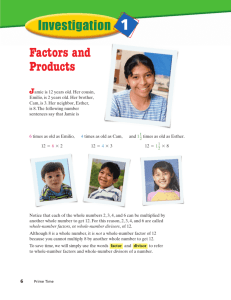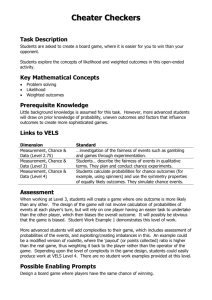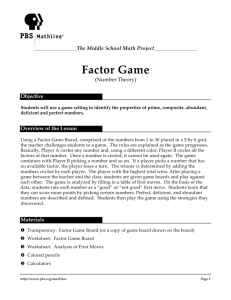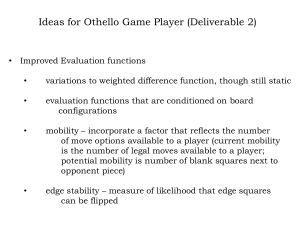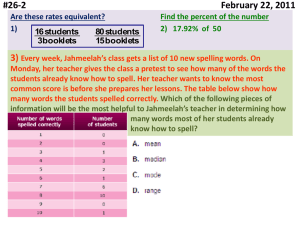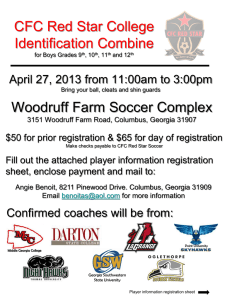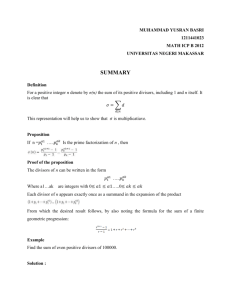Factor Game
advertisement
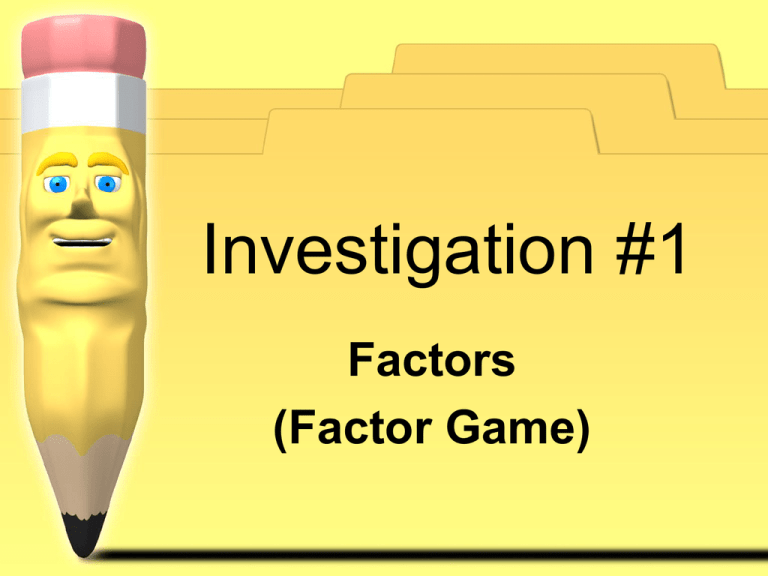
Investigation #1 Factors (Factor Game) 1.1 Playing the Factor Game • Factors – one of two whole numbers that are multiplied to get a product • Example – x = 12 and are factors of 12 1.1 Playing the Factor Game • Divisors – number that divides a given number with no remainder, divisors and factors are the same for a given number • Example – 12 ÷ = and are divisors of 12 and are also factors of 12 Playing the Factor Game 1. Player A chooses a number on the game board and circles it. 2. Using a different color, Player B circles all the proper factors of Player A’s number. The proper factors of a number are all the factors of that number, except the number itself. For example, the proper factors of 12 are 1, 2, 3, 4, and 6. Although 12 is a factor of itself, it is not a proper factor. 3. Player B circles a new number, and Player A circles all the factors of the number that are not already circled. 4. The players take turns choosing numbers and circling factors. 5. If a player circles a number that has no factors left that have not been circled, then that player does not get the points for the number circled and loses the next turn. 6. The game ends when there are no numbers left with uncircled factors. 7. Each player adds the numbers that are circled with his or her color. The player with the greater total is the winner. Problem 1.1 Finding Proper Factors A. Play the Factor Game several times with a partner. Take turns making the first move. Look for moves that will give you more points than your opponent. As you play, write down any strategies you find. Playing the Factor Game 1 2 3 4 5 6 7 8 9 10 11 12 13 14 15 16 17 18 19 20 21 22 23 24 25 26 27 28 29 30 http://www.phschool.com/atschool/cmp2/active_math/site/Grade6/FactorGame/ Problem 1.1 Finding Proper Factors B. How can you test to determine whether a number is a factor of another number? C. If you know a factor of a number, can you find another factor? Explain your thinking. D. Give an example of a number that has many factors and an example of a number that has few factors. E. Make a list of the factors of 18. Make a list of the divisors of 18. Are the factors of a number also divisors of the number? Explain your thinking. F. How do you know when you have found all the factors of a number? Problem 1.2 Playing to Win The Factor Game Now you will make a table to analyze the Factor Game and look for patterns. First Move 1 2 3 4 5 6 7 8 9 Proper Factors My Score Opponent’s Score A. 1. Make a table of all the possible first moves (numbers from 1 to 30) in the Factor Game. 2. For each move, list the proper factors of the number, and record the scores you and your opponent would receive. 3. Describe an interesting pattern you see in your table. Problem 1.2 Prime and Composite Numbers B. What is the best first move? Why? C. Which first move would make you lose your next turn? Why? D. Other than your answer to Question C, what is the worst first move? Why? E. List all the first moves that allow your opponent to score only one point. These numbers are called prime numbers. F. Are all prime numbers good first moves? Explain. (Remember, a number is a good first move if the player choosing the number scores more points than his or her opponent.) G. List all the first moves that allow your opponent to score more than one point. These numbers also have a special name. They are called composite numbers. H. Are composite numbers good first moves? Explain. Backdrops: www.animationfactory.com - These are full sized backdrops, just scale them up! - Can be Copy-Pasted out of Templates for use anywhere!
